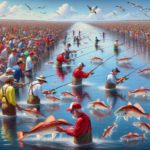Walleye War in Ohio
Introduction
Imagine casting your line into the serene waters of Lake Erie, only to find yourself in the midst of a heated conflict known as the “Walleye War.” This term might sound dramatic, but it encapsulates the intense competition and controversy surrounding walleye fishing in Ohio. This article will delve into the historical, cultural, and ecological aspects of the Walleye War, offering insights into fishing techniques, species information, top fishing spots, and more. Whether you’re an avid angler or a curious reader, understanding the Walleye War is crucial for appreciating the complexities of fishing in Ohio.
Background/Context
Historical or Cultural Significance
The Walleye War in Ohio is not just a modern phenomenon; it has deep historical roots. Walleye, a prized game fish, has been a staple in the diets and cultures of Native American tribes in the Great Lakes region for centuries. The fish’s popularity surged in the 20th century, leading to increased fishing pressure and subsequent conflicts over fishing rights and regulations. The term “Walleye War” gained prominence in the late 20th century, highlighting the tensions between commercial and recreational fishers, as well as between different states and countries bordering the Great Lakes.
Geographical Overview
Ohio’s Lake Erie coastline stretches for about 312 miles, offering a diverse range of fishing environments. The lake’s western basin is particularly renowned for its walleye population, thanks to its shallow waters and abundant food sources. The region’s climate, characterized by cold winters and warm summers, creates ideal conditions for walleye spawning and growth. The local ecosystem, including various aquatic plants and smaller fish species, supports a thriving walleye population.
Key Points/Details
Fishing Techniques
Technique Overview
Walleye fishing in Ohio primarily involves trolling, jigging, and casting. Trolling is popular for covering large areas and locating schools of walleye. Jigging, on the other hand, is effective for targeting specific spots, especially during colder months when walleye are less active. Casting with crankbaits or soft plastics is another common technique, particularly in shallow waters.
When and Where to Use
Trolling is best used in open waters during the warmer months when walleye are more dispersed. Jigging is ideal for colder months and deeper waters, such as around reefs and drop-offs. Casting is effective in the spring and fall when walleye move to shallower waters for spawning and feeding.
Recommended Gear
- Rods: Medium to medium-heavy action rods.
- Reels: Spinning or baitcasting reels with a smooth drag system.
- Lines: Braided line for trolling and jigging; fluorocarbon for casting.
- Bait/Lures: Crankbaits, jigs, soft plastics, and live bait like minnows or nightcrawlers.
Species Information
Species Overview
Walleye (Sander vitreus) are known for their elusive nature and excellent table fare. They prefer cooler, deeper waters during the day and move to shallower areas at night. Walleye are most active during low-light conditions, such as dawn and dusk.
Best Practices
To successfully catch walleye, focus on fishing during low-light periods and use techniques that mimic their natural prey. Pay attention to water temperature and structure, as walleye often congregate around drop-offs, reefs, and submerged vegetation. Using electronics to locate schools of fish can also significantly improve your success rate.
Location Information
Top Fishing Spots
- Western Basin: Known for its shallow waters and abundant walleye population.
- Central Basin: Offers deeper waters and is ideal for summer trolling.
- Sandusky Bay: A hotspot during the spring spawning season.
- Maumee River: Famous for its walleye run in early spring.
Regulations and Licenses
Ohio requires a fishing license for anyone over the age of 16. Specific regulations for walleye include a daily bag limit and size restrictions, which can vary by season and location. Always check the Ohio Department of Natural Resources (ODNR) website for the most current regulations.
Seasonal Considerations
Seasonal Variations
Walleye fishing conditions in Ohio change throughout the year. Spring is prime time for shallow water fishing as walleye move inshore to spawn. Summer sees walleye moving to deeper, cooler waters, making trolling more effective. Fall offers another opportunity for shallow water fishing as walleye feed heavily before winter. Winter ice fishing can also be productive, particularly in the western basin.
Best Times to Fish
The best times to fish for walleye are during the spring and fall when they are most active in shallower waters. Early morning and late evening are generally the most productive times of day.
Events and Tournaments
Event Overview
Ohio hosts several walleye fishing tournaments throughout the year, attracting anglers from across the country. Notable events include the Lake Erie Walleye Trail (LEWT) and the Walleye Fall Brawl.
Preparation Tips
To prepare for a tournament, familiarize yourself with the specific rules and regulations, practice your techniques, and ensure your gear is in top condition. Pre-fishing the tournament waters can also give you a competitive edge.
Tips and Best Practices
General Tips
- Use electronics to locate schools of walleye.
- Pay attention to water temperature and structure.
- Fish during low-light conditions for the best results.
Avoid Common Mistakes
- Not adjusting techniques based on seasonal changes.
- Using the wrong type of bait or lures.
- Ignoring local regulations and size limits.
Advanced Techniques
- Using planer boards to spread out your lines while trolling.
- Employing drop-shot rigs for precise bait placement.
- Experimenting with different lure colors and sizes to match local forage.
Gear and Equipment Recommendations
Essential Gear
- Medium to medium-heavy action rods.
- Spinning or baitcasting reels.
- Braided and fluorocarbon lines.
- Crankbaits, jigs, soft plastics, and live bait.
Optional Gear/Upgrades
- Planer boards for trolling.
- High-quality fish finders and GPS units.
- Electric trolling motors for precise boat control.
Where to Buy or Rent
Local bait and tackle shops around Lake Erie offer a wide range of gear and equipment. Online retailers like Bass Pro Shops and Cabela’s also provide extensive selections. For rentals, check with local marinas and fishing charters.
Safety and Conservation
Safety Tips
- Always wear a life jacket when on the water.
- Check weather conditions before heading out.
- Be aware of local wildlife and potential hazards.
Conservation Practices
- Practice catch and release to help sustain walleye populations.
- Respect local wildlife and habitats.
- Follow all fishing regulations and size limits.
Planning Your Trip
Accommodations
There are numerous lodging options near Lake Erie, ranging from campgrounds and RV parks to hotels and vacation rentals. Popular areas include Port Clinton, Sandusky, and Marblehead.
Travel Tips
Lake Erie is accessible via several major highways, including I-90 and I-80. The nearest major airports are Cleveland Hopkins International Airport (CLE) and Toledo Express Airport (TOL). Renting a car is recommended for exploring the region.
Additional Activities
Beyond fishing, the Lake Erie region offers a variety of activities, including boating, hiking, bird watching, and visiting local attractions like Cedar Point amusement park and the Lake Erie Islands.
Frequently Asked Questions (FAQs)
What is the best time of year to fish for walleye in Ohio?
The best times are during the spring and fall when walleye are most active in shallower waters.
Do I need a fishing license to fish for walleye in Ohio?
Yes, anyone over the age of 16 needs a fishing license. Check the ODNR website for specific regulations.
What are the best techniques for catching walleye?
Trolling, jigging, and casting are the most effective techniques, depending on the season and water conditions.
Conclusion
The Walleye War in Ohio is a multifaceted issue that encompasses historical, cultural, and ecological dimensions. By understanding the best fishing techniques, species behavior, top fishing spots, and seasonal variations, anglers can enhance their walleye fishing experience. Whether you’re preparing for a tournament or planning a leisurely fishing trip, this comprehensive guide provides all the information you need to succeed. So grab your gear, head to Lake Erie, and join the ranks of those who have experienced the thrill of walleye fishing in Ohio.


